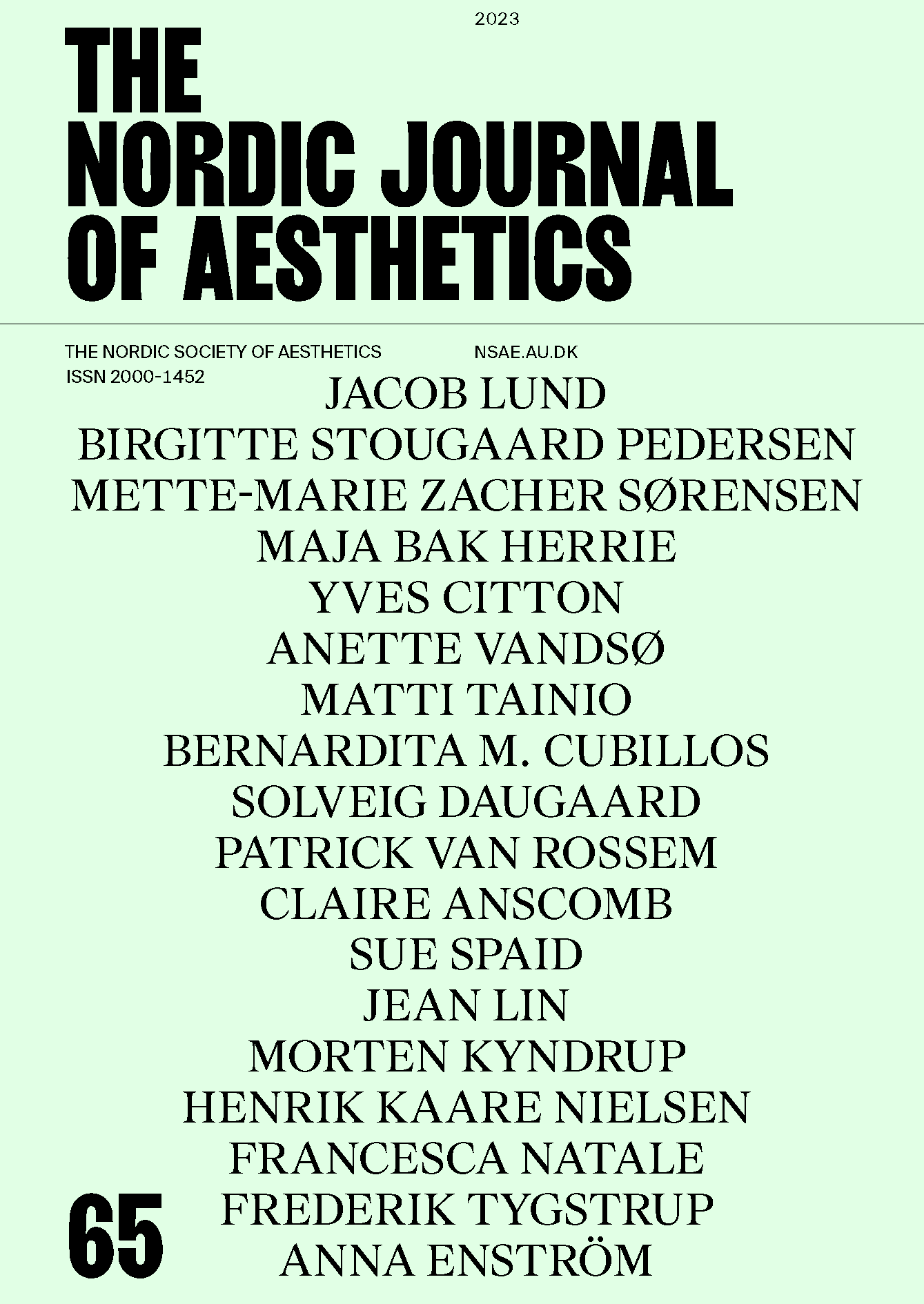Stay with Me: Uncertain Indices and Attentional Presence in Chat Interfaces
DOI:
https://doi.org/10.7146/nja.v32i65.140199Keywords:
Everyday Aesthetics, Attention, Typing Indicators, Chat Interfaces, Uncertain Indices, CareAbstract
In this article, Herrie and Sørensen examine the mediation of typing indicators (“…”) in online messaging. Their point of departure is a scene from the contemporary novel Exciting Times by Naoise Dolan (2020), in which the ‘dots’ play a prominent role. Their analysis shows how typing indicators, as interface design, mediate the complex communication situation in which they take part: from being mere signals, they have slipped into our emotional lives. From a semiotic perspective (Charles S. Peirce), the authors define typing indicators as uncertain indices which through unknowability and suspense establish an attentional presence. In continuation hereof, the authors argue that the acts of writing and waiting in contemporary attentional ecologies (Yves Citton) through the mediation of typing indicators as indicators of attentional presence, could be considered a mode of caring (Bernard Stiegler).
References
Naoise Dolan, Exciting Times (New York: Ecco Press, 2020).
Xuan Juliana Wang, “In ‘Exciting Times,’ Echoes of Sally Rooney, but With a Queer Twist,” New York Times, June 2, 2020, https://www.nytimes.com/2020/06/02/books/review/exciting-times-naoisedolan.html, or Cecilia Pizzaghi, “Exciting Times: A Millennial Novel about Identity and Idleness,” Hybercritic, 2020, https://www.hypercritic.org/read/literature/naoise-dolan-exciting-times-a-millennialnovel-2020-preview/.
Ulrich Gnewuch, Stefan Morana, Marc T. P. Adam, and Alexander Maedche,“‘The Chatbot Is Typing …’ The Role of Typing Indicators in Human-Chatbot Interaction,” Proceedings of the 17th Annual Pre-ICIS Workshop on HCI Research in MIS, San Francisco, CA., December 13, 2018.
David Auerbach, “I Built That ‘So-and-So Is Typing’ Feature in Chat,” Slate, February 12, 2014, https://slate.com/technology/2014/02/typingindicator-in-chat-i-built-it-and-im-not-sorry.html.
Georgina Berbari, “What it Really Means when the ‘Someone’s Typing’ Indicator Shows Up,” Considerable, November 25, 2019, https://www.considerable.com/home/technology/texting-indicator-bubbles-explained/.
Bas Aarts, “Subjunctive,” The Oxford Dictionary of English Grammar, 2. edition (Oxford: Oxford University Press, 2014), https://doi.org/10.1093/acref/9780199658237.001.0001.
Edward Butscher, Sylvia Plath: Method and Madness (Tucson: AZ Schaffner Press, 2003).
Ben Crair, “I Can See You Typing: The Most Awkward Part of Online Chat,” The Statesman, January 31, 2014, https://www.newstatesman.com/uncategorized/2014/01/i-can-see-you-typing-most-awkward-part-onlinechat.
Charles Sanders Peirce, The Collected Papers of Charles Sanders Peirce, Volume 2: Elements of Logic, ed. Charles Hartshorne and Paul Weiss (Charlottesville: Belknap Press of Harvard University Press, 1994), 2.285.
Floyd Merrell, “Charles Sanders Peirce’s Concept of Sign,” in The Routledge Companion to Semiotics and Linguistics, ed. Paul Cobley (London and New York: Routledge 2001), 28–39, https://doi.org/10.4324/9780203996089.
Yves Citton, The Ecology of Attention (Cambridge: Polity Press, 2017).
Hartmut Rosa, “Acceleration and Resonance: An Interview with Hartmut Rosa,” interview by Bjørn Schiermer, E-Special: Four Generations of Critical Theory in Acta Sociologica, Acta Sociologica, 3, ´ 2017.
Bernard Stiegler, “Relational Ecology and the Digital Pharmakon,” Culture Machine 13 (2012).
Downloads
Published
How to Cite
Issue
Section
License
Copyright (c) 2023 Maja Bak Herrie, Mette-Marie Zacher Søresen

This work is licensed under a Creative Commons Attribution 4.0 International License.
Authors who publish with this journal agree to the following terms:
- Authors retain copyright and grant the journal right of first publication with the work simultaneously licensed under a Creative Commons Attribution License that allows others to share the work with an acknowledgement of the work's authorship and initial publication in this journal.
- Authors are able to enter into separate, additional contractual arrangements for the non-exclusive distribution of the journal's published version of the work (e.g., post it to an institutional repository or publish it in a book), with an acknowledgement of its initial publication in this journal.
- Authors are permitted and encouraged to post their work online (e.g., in institutional repositories or on their website) prior to and during the submission process, as it can lead to productive exchanges, as well as earlier and greater citation of published work (See The Effect of Open Access).




